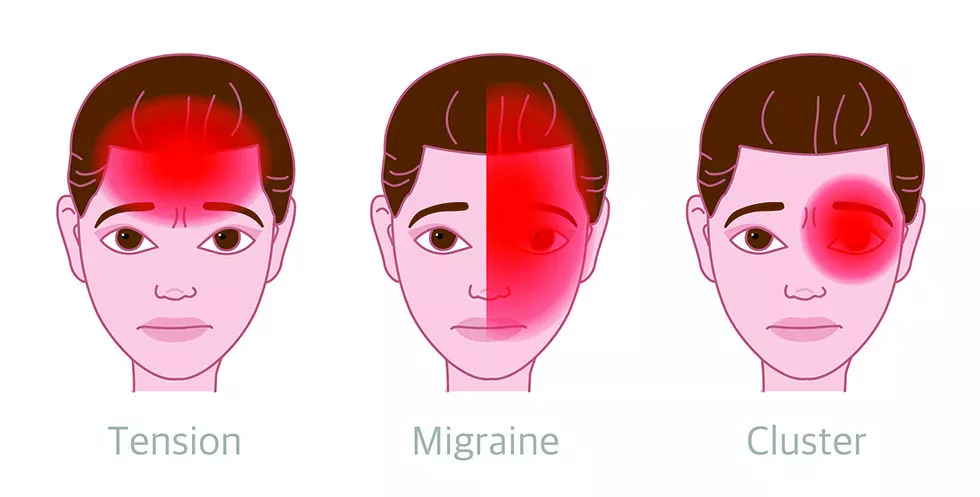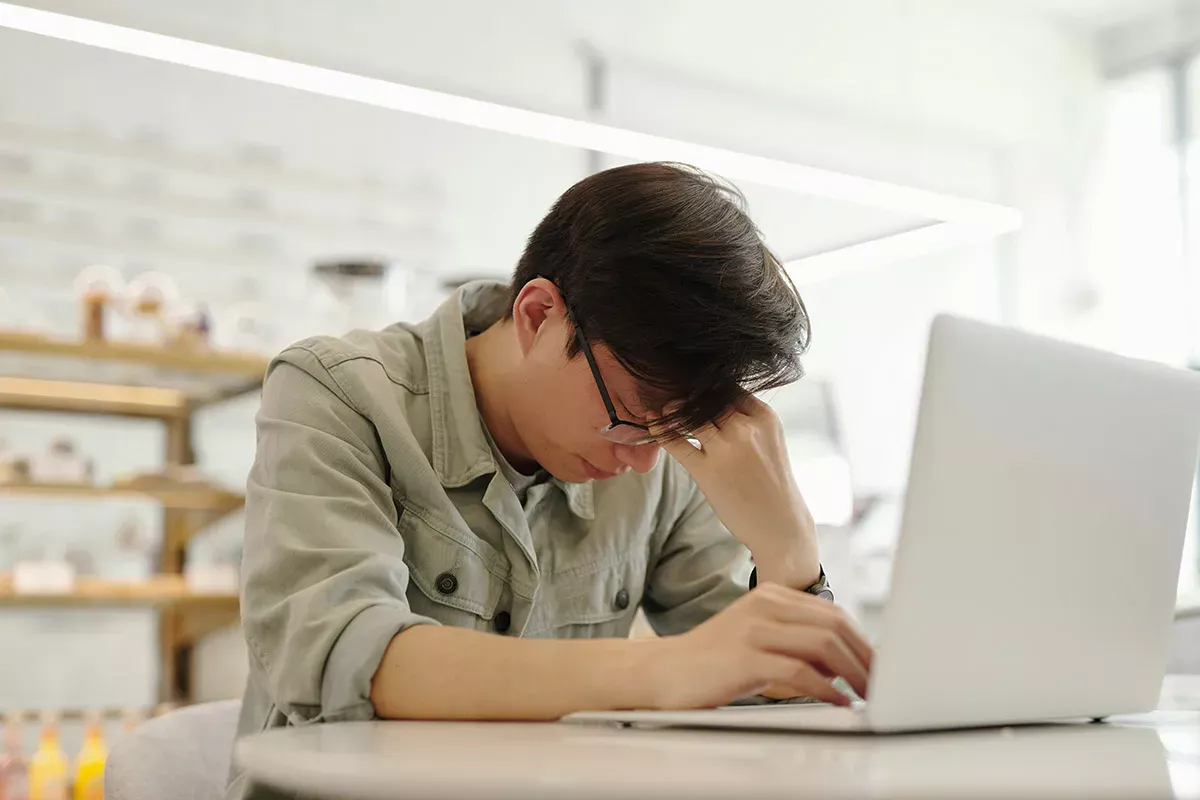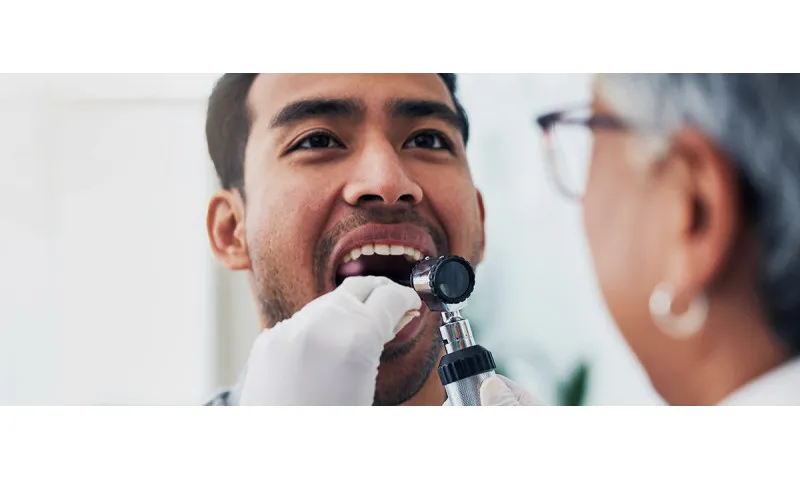What are headaches?
Headaches (technical term: cephalgia) are widespread and are even one of the most common forms of pain. No wonder: sooner or later, everyone experiences headaches - often several times a year. The intensity and perception can be very different: there are pressing, throbbing, stabbing or dull headaches. The pain can occur on one side on the right or left or on both sides. The whole head can hurt or only a limited part of it. The pain can be almost unbearable or barely perceptible. Frequent and intense headaches - such as migraines - can severely restrict quality of life, while mild and occasional headaches have hardly any impact on everyday life. As you can see, headaches cannot be lumped together.
Different types of headaches
Although there are over 200 different types of headache, most people suffer from one particular type: tension headaches. The second most common type is migraine. Rarer are cluster headaches. These three forms of headache have one thing in common: they are primary headaches. This means that the headache is the main symptom. In contrast, secondary headaches are caused by an underlying illness that manifests itself - among other things - with headaches as an accompanying symptom. Secondary headaches are much rarer than primary headaches. Let's take a closer look at the three most common forms of headache:
Tension headaches
If you have a headache right now, there is a very good chance that it is a tension headache - 90 per cent to be precise. You have probably experienced this type of headache before: the pain is dull and pressing and is felt by many sufferers like a band around the forehead, temples and back of the head. However, the top of the skull can also be affected. The intensity of the pain is usually mild to moderate.
The duration of the headache varies greatly: it can disappear after just a few minutes or remain for up to a week. They do not get worse with exercise. Tension headaches usually occur occasionally and are no cause for concern. They disappear on their own and can also be successfully treated with painkillers. This form of headache rarely becomes chronic.
Some sufferers may also experience sensitivity to light in addition to the headache; however, other accompanying symptoms such as nausea are not common. What often occurs at the same time, however, is tension and tenderness in the shoulder and neck area - which can also trigger the headache.
Causes of tension headaches
It is not yet clear exactly why tension headaches occur, what exactly happens in the head and why some people are affected more often than others. However, there are several factors that can trigger this form of headache:
- Tension in the neck and shoulder area (e.g. due to poor posture and sitting for long periods at work)
- Stress and mental strain
- Weather changes (temperature fluctuations and changes in air pressure)
- Alcohol (hangover)
- Smoking
- Too little sleep
- Poorly ventilated rooms (lack of oxygen)
- Lack of fluids
- Physical exertion and exercise (e.g. headaches after sport)
- Hormone fluctuations (for example headaches during or before your period)
- Heat and prolonged exposure to the sun
Migraine
Migraine headaches occur much less frequently than tension-type headaches and are also much more severe. Accordingly, they also restrict sufferers much more in their everyday lives. Women are more frequently affected by migraines than men - often before or during their period. Children can also suffer headaches in the form of migraine attacks. In Germany, around 12-15 per cent of women and 8 to 10 per cent of men are affected.
People who suffer from migraines describe headache attacks as throbbing, pulsating or hammering one-sided pain that occurs mainly in the front of the head - for example on the right or left side of the forehead. The headache can also change sides. The pain intensity is moderate to severe and the pain can last from four hours to three days and intensifies with movement. Migraine attacks can be shorter in children and adolescents.
In addition to headaches, migraine attacks are often accompanied by other symptoms:
- Nausea (sometimes even vomiting)
- Light sensitivity
- Noise sensitivity
- Odour sensitivity
Due to the severe pain and the accompanying symptoms, sufferers often have to withdraw to a dark place and lie down during a migraine attack.
A migraine attack can also be heralded by a so-called migraine aura or be accompanied by it. It usually subsides within an hour.
Symptoms of a migraine aura are
- Flickering before the eyes
- Blurred vision
- Tingling in arms and legs
- Word-finding disorders
- Dizziness
Causes of migraine headaches
The causes of migraines are complex: on the one hand, there appears to be a genetic component. On the other hand, the processing of stimuli also seems to play a major role. Those affected find it difficult to relax and use up a lot of energy to perceive all the stimuli in the environment. If the brain is then overloaded, headaches occur. There are also factors that favour migraine attacks: stress, hormonal fluctuations, changes in the weather, alcohol consumption, but also taking the contraceptive pill and too little or too much sleep can trigger migraine attacks.
Cluster headaches
Cluster headaches are even more intense than migraine headaches, but much less frequent. The pain is described by sufferers as stabbing, burning or drilling and can last between 15 minutes and three hours. With these headaches, the name says it all: "cluster" refers to the fact that the pain occurs more frequently in episodes lasting several weeks - sometimes several times a day and even at the same time of day.
Cluster headaches always occur on one side and begin behind the right or left eye. Typical accompanying symptoms are
- Reddened eye on the affected side
- Swollen and reddened eyelid on the affected side
- Tearing of the eyes on the affected side
- Runny nose or nasal congestion
Unlike migraine headaches, sufferers are often restless due to the extreme pain and tend to pace up and down. The gender distribution is also the other way round: cluster headaches are more common in men.
Causes of cluster headaches
The causes of cluster headaches have not yet been sufficiently clarified. However, they occur more frequently after drinking alcohol and with a lack of sleep. Light stimuli can also trigger cluster headaches.
Causes of headaches
You have already learnt about the triggers for the three most common forms of headache. At this point, we want to take a closer look at some of the triggering factors and also look at secondary types of headache.
Headaches and stress
The link between tension headaches and migraines and stress has long been well documented. People who find it difficult to relax, tend to brood or have difficulty expressing their feelings are particularly likely to suffer from headaches. Stress at work, family or relationship problems or financial worries are also stress factors that can lead to headaches. This is also referred to as psychosomatic headaches. Children and adolescents are also affected: Headaches can occur when there is a lot of pressure at school, family stress or too much free time. During puberty , social pressure from friends and classmates is an additional stress factor.
However, stress not only has a psychological component, but also a physical one: constant stress leads to tension in the muscles. This in turn can lead to increased sensitivity of the pain centres in the brain and thus to headaches. Anyone who thinks they have to power through out of a sense of duty will soon get the bill: even more severe headaches.
In addition, migraines often lead to a vicious circle of self-fulfilling prophecies for important events that the sufferer does not want to miss. The unpredictability of migraine attacks is a major stress factor. If sufferers worry too much about the fact that they could fail and become obsessed with this problem, they put themselves under pressure. As a result, the increased emotional stress can actually lead to a migraine attack.
Headaches are also particularly common after prolonged crying: When we are grieving or under great stress and shed a lot of tears, our head starts to hurt. The exact cause of this is not yet known. However, scientists suspect that this phenomenon is linked to the release of the stress hormone cortisol.
Headaches due to CMD
If your head hurts, the jaw may be to blame. Craniomandibular dysfunction (CMD) is a disorder of the chewing function: teeth, jaw bones, jaw joints and muscles do not interact harmoniously and the teeth cannot bite together properly. The jaw muscles try to compensate for this and become tense in the process. As our muscles are connected to each other via muscle chains, this tension can spread to the shoulder and neck area. Tense jaw muscles can also lead to unfavourable displacement of the skull bones. The spiral of tension can run through the entire body and cause neck and back pain as well as jaw pain and headaches.
In the case of CMD, it is important to find the cause of the imbalance and correct it. This can be a misaligned tooth or tooth loss, for example, but poor posture or ill-fitting dentures can also trigger CMD. Stress also plays a role: some people tend to grind their teeth when stressed. This causes tension in the jaw muscles and can also damage the teeth. Both can trigger an imbalance in chewing function.
Good to know:
You can find out how to determine whether you suffer from craniomandibular dysfunction (CMD) and what exactly the treatment looks like here:
Dental problems as a cause of headaches
What many people don't realise: Our dental health is also important when it comes to headaches. For example, toothache can radiate and cause headaches in the event of root inflammation. Tooth root inflammation can also spread to the maxillary sinus and cause inflammation there, which can also trigger headaches. During root canal treatment, it can also happen that the filling material is accidentally pushed beyond the tip of the root, causing the foreign body in the maxillary sinus to become inflamed.
Another point: amalgam fillings and metal-containing crowns and bridges can cause many different disorders in the body - including headaches. If you have metal or amalgam in your mouth, you may be able to get rid of your headaches by switching to all-ceramic dentures.
However, stress not only has a psychological component, but also a physical one: constant stress leads to tension in the muscles. This in turn can lead to increased sensitivity of the pain centres in the brain and thus to headaches. Anyone who thinks they have to power through out of a sense of duty will soon get the bill: even more severe headaches.
In addition, migraines often lead to a vicious circle of self-fulfilling prophecies for important events that the sufferer does not want to miss. The unpredictability of migraine attacks is a major stress factor. If sufferers worry too much about the fact that they could fail and become obsessed with this problem, they put themselves under pressure. As a result, the increased emotional stress can actually lead to a migraine attack.
Headaches are also particularly common after prolonged crying: When we are grieving or under great stress and shed a lot of tears, our head starts to hurt. The exact cause of this is not yet known. However, scientists suspect that this phenomenon is linked to the release of the stress hormone cortisol.
Headaches due to CMD
If your head hurts, the jaw may be to blame. Craniomandibular dysfunction (CMD) is a disorder of the chewing function: teeth, jaw bones, jaw joints and muscles do not interact harmoniously and the teeth cannot bite together properly. The jaw muscles try to compensate for this and become tense in the process. As our muscles are connected to each other via muscle chains, this tension can spread to the shoulder and neck area. Tense jaw muscles can also lead to unfavourable displacement of the skull bones. The spiral of tension can run through the entire body and cause neck and back pain as well as jaw pain and headaches.
In the case of CMD, it is important to find the cause of the imbalance and correct it. This can be a misaligned tooth or tooth loss, for example, but poor posture or ill-fitting dentures can also trigger CMD. Stress also plays a role: some people tend to grind their teeth when stressed. This causes tension in the jaw muscles and can also damage the teeth. Both can trigger an imbalance in chewing function.
Good to know:
Root canal treatment is usually necessary in the case of a root canal infection. You can find everything you need to know about this topic in our article:
Headaches and hormones
If the hormone balance is disrupted during the menopause, pregnancy or the menstrual cycle, this can manifest itself in the form of headaches. Both during the menopause and in the second half of the menstrual cycle (after ovulation), the body produces less oestrogen. This can lead to headaches and other symptoms such as abdominal pain. Experts refer to this as premenstrual syndrome (PMS). Women can also suffer from increased headaches during their period (especially migraines).
Important: The pill can also favour migraine attacks. If you are taking the pill and suffer from frequent migraine attacks, it may be worth switching to a different preparation or contraceptive method.
Headaches during pregnancy
Hormone fluctuations are of course also noticeable during pregnancy. Migraine patients suffer more headaches in the first trimester in particular. The good news: in the last two trimesters and during breastfeeding, migraine attacks occur much less frequently than usual.
Tension headaches are not uncommon during pregnancy. Although headaches are not a classic pregnancy complaint, some women have more frequent headaches during pregnancy than usual. However, the reasons for this are the same as for normal tension headaches - for example, increased stress and a lack of fluids.
Particularly important: You are not allowed to take all painkillers during pregnancy. Paracetamol is permitted throughout pregnancy in limited doses (e.g. once a week). You should stay away from ibuprofen and ASA.
While some women get severe sudden headaches shortly before the birth, headaches after the birth are very common. For example, 30 to 40 per cent of mothers suffer from headaches in the postpartum period.
Good to know:
Did you know that pregnancy can have an impact on your dental health? Find out what you should look out for in our article:
Headaches from taking painkillers too often
If you take painkillers for headaches more than ten days a month, you run the risk of making them worse. On the one hand, headaches then occur more frequently and last longer, and on the other hand, the painkillers work less effectively. In the worst-case scenario, a permanent headache develops, leaving sufferers with the feeling that they no longer have a clear head.
If you take painkillers very frequently, you should definitely take a break. You may experience more pain in the short term. However, the headache should then improve in the long term.
Headache as a deficiency or withdrawal symptom
The human body reacts sensitively when it lacks things that it needs or to which it has become accustomed - and shows this in the form of headaches, among other things. If you have eaten or drunk too little, for example when fasting, headaches are a warning sign from your body. However, a lack of fluids is not only caused by insufficient fluid intake: we can also get headaches after a sauna or after sport - when we dehydrate the body by sweating profusely. Iron deficiency also quickly leads to headaches.
Even if we suddenly change our diet, the body can react with headaches: Sugar deprivation is a very good idea and is definitely good for our body in the long term: you sleep better, feel fitter and inflammation throughout the body decreases. However, the initial period is not necessarily easy. In addition to headaches, your body can react with a very irritable and bad mood, skin blemishes, dizziness and even tremors - after all, it really is a withdrawal. It's not for nothing that sugar is often compared to hard drugs because of its addictive effect, where withdrawal also causes headaches, among other things.
Speaking of drugs: caffeine is a socially accepted drug. When we supply our body with caffeine via coffee, cola, tea or energy drinks, it gets used to the daily intake. Caffeine withdrawal often leads to headaches and a feeling of fatigue and exhaustion.
Good to know:
Do you want to do something good for your body and give up sugar? Find out how to survive sugar withdrawal in our article:
Sugar-free diet
Other causes of secondary headaches
The following diseases can cause headaches as a concomitant symptom:
- Food intolerances
- Allergies (for example hay fever)
- Infectious diseases such as influenza, corona (including long Covid) and colds; especially when bending over if the sinus cavity is inflamed (often in combination with cough, sore throat, earache, aching limbs and fatigue);
- High blood pressure (often in combination with nosebleeds), but also low blood pressure
- Uncorrected visual impairment
- Gastrointestinal disorders (often in combination with diarrhoea and abdominal pain)
- Lyme disease or TBE after tick bite (in combination with very strong photosensitivity)
- Meningitis
- Diabetes (with hypoglycaemia)
- Concussion after a fall or accident
- Injuries to the head and cervical spine (craniocerebral trauma, slipped disc)
- Glaucoma
- Lung diseases that lead to reduced oxygen uptake (chronic pneumonia, bronchial asthma)
- Stroke
- Tumour in the back of the head (brain tumour)
Before you start worrying that a tumour could be the cause of your headache, here is an important tip: even severe headaches are usually harmless and only very rarely a sign of a tumour. However, caution is advised if the headache occurs mainly at night when lying down and improves during the day, does not respond to conventional painkillers and gets worse over time. You should then have yourself examined by a neurologist as a precaution.
Even if we suddenly change our diet, the body can react with headaches: Sugar deprivation is a very good idea and is definitely good for our body in the long term: you sleep better, feel fitter and inflammation throughout the body decreases. However, the initial period is not necessarily easy. In addition to headaches, your body can react with a very irritable and bad mood, skin blemishes, dizziness and even tremors - after all, it really is a withdrawal. It's not for nothing that sugar is often compared to hard drugs because of its addictive effect, where withdrawal also causes headaches, among other things.
Speaking of drugs: caffeine is a socially accepted drug. When we supply our body with caffeine via coffee, cola, tea or energy drinks, it gets used to the daily intake. Caffeine withdrawal often leads to headaches and a feeling of fatigue and exhaustion.
Diagnosis: When to see a doctor for headaches?
You already know that most headaches are harmless and go away on their own. However, there are some situations in which you should have a medical examination:
- The headaches keep coming back.
- You've had a headache for days and it won't go away.
- You had a head injury.
- You also suffer from nausea and vomiting.
- You also have a fever.
- You are over 50 and are suffering from this type of headache for the first time.
- If an extreme headache suddenly occurs in combination with visual, hearing or speech disorders, confusion, motoric deficits or unconsciousness, call an ambulance immediately! This could be a cerebral haemorrhage.
As a general rule, headaches in children and pregnant women should always be examined. If you are wondering which doctor is the right one: children should see a paediatrician; adults can first be examined by their family doctor and, if necessary, referred to a neurologist. There is no general answer as to whether you can get a sick note because of headaches. Your doctor will judge this on an individual basis.
Good to know:
Ideally, you should keep a pain diary in which you note when you had a headache, how long it lasted, what you did about it (e.g. taking painkillers) and whether a triggering factor can be recognised (e.g. menstrual cycle).
Procedure of the examination
If you go to the doctor with a headache, he will first ask you some questions about the pain to determine what type of headache it is.
For example:
- Where do the headaches occur?
- How long do they last?
- How often do the headaches occur?
- What type of pain is there? (for example: pressing, throbbing, stabbing)
- Which factors change the headaches (for example: weather, menstrual cycle, exercise)
- How severe is the pain?
This is followed by a physical examination. If necessary, additional imaging procedures or further examinations may be used. This is particularly the case with secondary headaches. These include:
- Computed tomography (CT)
- Magnetic resonance imaging (MRI)
- Lumbar puncture (removal of cerebrospinal fluid from the lumbar spine to investigate whether meningitis is present; this examination procedure leads to headaches when sitting up in ten per cent of patients)
- X-ray of the spine and skull
If you suspect that your teeth could be responsible for the headache, you may also be referred to a dentist.
Treatment: What to do for headaches?
You can often get rid of ordinary tension headaches with home remedies or simple lifestyle adjustments. Painkillers can help with severe pain. However, if you suffer from migraine or cluster headaches, more complex treatment is required. In this section, we present proven remedies for relieving headaches.
Adapt your lifestyle
Some factors that can cause headaches can be easily remedied: poorly ventilated rooms, poor posture, lack of sleep and fluids and headaches caused by uncorrected poor eyesight. Ventilate well or go out into the fresh air at the first sign of a headache. Drink something and - if possible - take a nap. Make sure that you wear your glasses or contact lenses regularly if you have prescription. These measures alone can often bring about an improvement.
A change in diet can also make a difference: many people with chronic headaches or migraines feel an improvement in their symptoms when they eat a low-histamine diet. In addition, this generally applies to all people: The entire metabolism benefits from a low-carbohydrate diet with as little white flour and sugar as possible.
Good to know:
What exactly are histamines and what does a low-histamine diet look like? You can find out here:
Low histamine diet
Home remedies for headaches
If you have a normal headache, you don't have to reach for a painkiller straight away. Start by drinking some water to keep your body hydrated. Teas, applications with essential oils and cold are also suitable home remedies for headaches.
Tea and coffee for headaches
Willow bark tea has a pain-relieving effect and works in a similar way to a painkiller. In general, waiting and drinking tea is a good strategy against headaches - especially if they are caused by a lack of fluids. Suitable varieties include:
- Ginger
- Camomile
- Clove
- Juniper blossoms
- Woodruff
- Hibiscus flowers
- Rose petals
A strong coffee - for example an espresso - can also help with severe migraine headaches. The caffeine constricts the blood vessels in the brain, which are dilated during a migraine and are therefore responsible for the pain. But please don't overdo it: Too much coffee can trigger another headache.
Essential oils
Peppermint, tea tree and lavender oil have a cooling and revitalising effect that can relieve headaches. The best way to do this is to use a 10 per cent oil and rub a few drops into your forehead, temples and neck. A bath with essential oils can also relieve headaches and generally reduce stress. Hot baths with peppermint oil, lemon oil or lavender oil are known to have a relaxing effect.
Cold
When we have a headache, we find the cold pleasant. The reason for this is that blood vessels contract when it is cold. Cool your forehead and temples with an ice pack, cold pack or the good old damp flannel. Many people also find it pleasant to run cold water over their face, arms or legs.
A change in diet can also make a difference: many people with chronic headaches or migraines feel an improvement in their symptoms when they eat a low-histamine diet. In addition, this generally applies to all people: The entire metabolism benefits from a low-carbohydrate diet with as little white flour and sugar as possible.
Relaxation against tension headaches
Tension headaches often occur when our neck and shoulder muscles are tense - for example due to incorrect posture at the desk or sitting for long periods without moving. The logical antidote: relaxation! On the one hand, targeted exercises to relax the muscles in the neck area help to relieve this tension. On the other hand, relaxation exercises for the whole body are also helpful - for example progressive muscle relaxation according to Jacobsen, autogenic training or meditation. A hot bath, a long walk in the fresh air or spending time with loved ones can also have a very relaxing effect.
Good to know:
Find out which exercises help against neck pain and what else you can do against neck pain here:
Sport
Endurance sports such as swimming, cycling and jogging have been proven to reduce stress levels. Stress hormones are reduced and general tension decreases. This is particularly important for frequent tension headaches and migraines. After all, stress is one of the most important triggers for headaches. So if you exercise regularly, you will suffer from headaches less often. Sports that strengthen the back muscles, such as yoga or Pilates, are particularly good at preventing tension headaches.
Magnesium
What many people don't realise: Magnesium can prevent headaches. This applies to both migraines and tension headaches. The mineral reduces the release of stress hormones and also protects against muscle tension. In a study in which migraine patients took 300 milligrams of magnesium twice a day for three months, the study participants were pleased with the significantly reduced intensity and duration of the pain.
Medication
Home remedies have their limits. If the headache doesn't go away or is too severe, you can resort to medication from the pharmacy.
Painkillers
You can take the following painkillers for common tension headaches:
- Ibuprofen
- Paracetamol
- Acetylsalicylic acid (ASS)
- Naproxen
It is important to note that you should not take painkillers for more than three days at a time and no more than ten days a month - otherwise you could make your headaches worse.
Triptans can also be used for migraine and cluster headaches. These are medications that not only relieve the headache, but also reduce accompanying symptoms such as nausea and vomiting. They are taken directly at the start of a headache attack. For very severe headaches, a nasal spray with the active ingredient triptan or injections under the skin can also be used. Various medications can also be prescribed to prevent migraine or cluster headaches.
When taking painkillers, the following generally applies: if you take more than the occasional tablet, you should seek medical advice.
Globules
Homeopathy offers a variety of globules to treat different types of headaches. It is best to seek advice from an alternative practitioner if you would like to try this. Bear in mind, however, that there is no scientific proof of the effectiveness of homeopathic remedies.
Psychological treatment of headaches
An extremely effective remedy for frequent to chronic headaches is a combination of three different forms of psychological treatment:
- Relaxation methods
- Biofeedback
- Cognitive behavioural therapy
These forms of psychological therapy can reduce the frequency of headaches by 30 to 60 per cent. One of the aims of the treatment is to improve the way people deal with stress.
Magnesium
What many people don't realise: Magnesium can prevent headaches. This applies to both migraines and tension headaches. The mineral reduces the release of stress hormones and also protects against muscle tension. In a study in which migraine patients took 300 milligrams of magnesium twice a day for three months, the study participants were pleased with the significantly reduced intensity and duration of the pain.
Medication
Home remedies have their limits. If the headache doesn't go away or is too severe, you can resort to medication from the pharmacy.
Painkillers
You can take the following painkillers for common tension headaches:
- Ibuprofen
- Paracetamol
- Acetylsalicylic acid (ASS)
- Naproxen
It is important to note that you should not take painkillers for more than three days at a time and no more than ten days a month - otherwise you could make your headaches worse.
Triptans can also be used for migraine and cluster headaches. These are medications that not only relieve the headache, but also reduce accompanying symptoms such as nausea and vomiting. They are taken directly at the start of a headache attack. For very severe headaches, a nasal spray with the active ingredient triptan or injections under the skin can also be used. Various medications can also be prescribed to prevent migraine or cluster headaches.
When taking painkillers, the following generally applies: if you take more than the occasional tablet, you should seek medical advice.
Globules
Homeopathy offers a variety of globules to treat different types of headaches. It is best to seek advice from an alternative practitioner if you would like to try this. Bear in mind, however, that there is no scientific proof of the effectiveness of homeopathic remedies.
Psychological treatment of headaches
An extremely effective remedy for frequent to chronic headaches is a combination of three different forms of psychological treatment:
- Relaxation methods
- Biofeedback
- Cognitive behavioural therapy
These forms of psychological therapy can reduce the frequency of headaches by 30 to 60 per cent. One of the aims of the treatment is to improve the way people deal with stress.
 Swiss premium oral care
Swiss premium oral care










